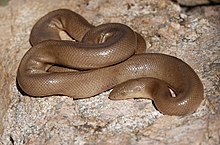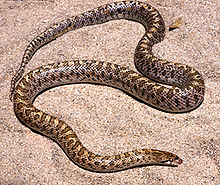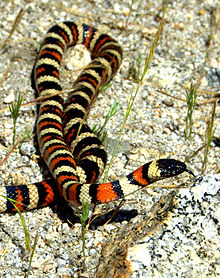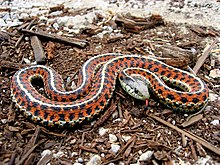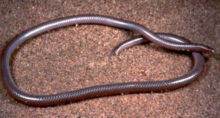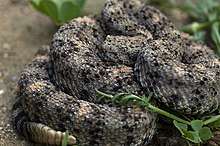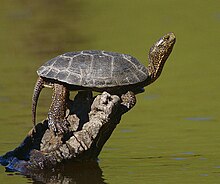Lizards
Family Anguidae
| Species | Common name | Occurrence | Photo |
|---|---|---|---|
| Elgaria coerulia | Northern alligator lizard | North of Monterey Bay and in the Sierra Nevada |  |
| Elgaria multicarinata | Southern alligator lizard | Throughout the state, excluding the deserts and most of the Central Valley |  |
| Elgaria panamintina [e] | Panamint alligator lizard | Inyo and Mono Counties |
Family Anniellidae
| Species | Common name | Occurrence | Photo |
|---|---|---|---|
| Anniella alexanderae [e] | Temblor legless lizard | Between California State Highway 33 and southeast base of Temblor Range, Kern County | |
| Anniella campi [e] | Southern Sierra legless lizard | Western Mojave Desert in Kern and Inyo Counties |  |
| Anniella grinnelli [e] | Bakersfield legless lizard | Southern San Joaquin Valley and the east side of the Carrizo Plain |  |
| Anniella pulchra [e] | Northern California legless lizard | Contra Costa County south to Ventura County |  |
| Anniella stebbinsi | Southern California legless lizard | Southern California south of the Transverse Ranges into northern Baja California |  |
Family Chamaeleonidae
| Species | Common name | Occurrence | Photo |
|---|---|---|---|
| Trioceros jacksonii [i] | Jackson's chameleon | San Luis Obispo, Los Angeles, and San Diego Counties |  |
Family Crotaphytidae
| Species | Common name | Occurrence | Photo |
|---|---|---|---|
| Crotaphytus bicinctores | Great Basin collared lizard | East of the Sierra Nevada |  |
| Crotaphytus vestigium | Baja California collared lizard | East of Peninsular Ranges south of Mount San Jacinto |  |
| Gambelia copeii | Cope's leopard lizard | Barely extends into CA, around Campo, San Diego County. |  |
| Gambelia sila [e] | Blunt-nosed leopard lizard | San Joaquin Valley |  |
| Gambelia wislizenii | Long-nosed leopard lizard | Mojave and Sonoran Deserts |  |
Family Dactyloidae
| Species | Common name | Occurrence | Photo |
|---|---|---|---|
| Anolis carolinensis [i] | Green anole | Coastal Southern California |  |
| Anolis sagrei [i] | Brown anole | Small isolated populations in San Diego County |  |
Family Eublepharidae
| Species | Common name | Occurrence | Photo |
|---|---|---|---|
| Coleonyx switaki | Switak's banded gecko | Borrego Springs south to Baja California |  |
| Coleonyx variegatus | Western banded gecko | Most of inland Southern California |  |
Family Gekkonidae
| Species | Common name | Occurrence | Photo |
|---|---|---|---|
| Cyrtopodionscabrum [i] | Rough-tailed gecko | Inyo County near Death Valley |  |
| Hemidactylus garnotii [i] | Indo-Pacific gecko | Los Angeles, Orange, and San Diego Counties |  |
| Hemidactylus mabouia [i] | Tropical house gecko | Orange and San Diego Counties |  |
| Hemidactylus turcicus [i] | Mediterranean house gecko | Southern California and San Joaquin Valley, scattered throughout the rest of the state | 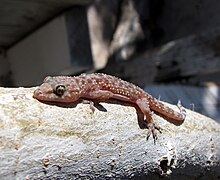 |
| Tarentola annularis [i] | Ringed wall gecko | Redlands, San Bernardino County |  |
| Tarentola mauritanica [i] | Moorish gecko | San Diego County | 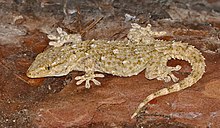 |
Family Helodermatidae
| Species | Common name | Occurrence | Photo |
|---|---|---|---|
| Heloderma suspectum | Gila monster | Scattered populations in Inyo, San Bernardino, Riverside, and Imperial Counties |  |
Family Iguanidae
| Species | Common name | Occurrence | Photo |
|---|---|---|---|
| Dipsosaurus dorsalis | Desert iguana | Mojave and Sonoran Deserts |  |
| Sauromalus ater | Common chuckwalla | Mojave and Sonoran Deserts excluding Algodones Dunes |  |
Family Lacertidae
| Species | Common name | Occurrence | Photo |
|---|---|---|---|
| Acanthodactylusboskianus [i] | Bosc's fringe-toed lizard | Coastal Ventura County |  |
| Podarcis siculus [i] | Italian wall lizard | San Pedro, Los Angeles County |  |
Family Phrynosomatidae
| Species | Common name | Occurrence | Photo |
|---|---|---|---|
| Callisaurus draconoides | Zebra-tailed lizard | Mojave and Sonoran Deserts |  |
| Petrosaurus mearnsi | Banded rock lizard | East of Peninsular Ranges south of San Gorgonio Pass |  |
| Phrynosoma blainvilli | Coast horned lizard | West of Sierra Nevada and deserts, north to the Bay Area, and inland as far north as Shasta Reservoir |  |
| Phrynosoma douglasii | Pygmy short-horned lizard | Far northeast near Oregon |  |
| Phrynosoma mcallii | Flat-tail horned lizard | Most of Colorado Desert, excluding Algodones Dunes |  |
| Phrynosoma platyrhinos | Desert horned lizard | Sonoran and Mojave Deserts and far northeast in Great Basin Desert | 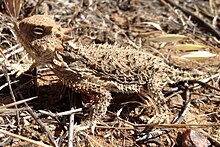 |
| Sceloporus becki [e] | Island fence lizard | Channel Islands | 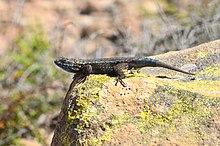 |
| Sceloporus graciosus | Common sagebrush lizard | Mountains surrounding Central Valley north to Oregon and east to Nevada |  |
| Sceloporus magister | Desert spiny lizard | Sonoran Desert |  |
| Sceloporus occidentalis | Western fence lizard | Throughout California excluding most of Sonoran and Mojave Deserts |  |
| Sceloporus orcutti | Granite spiny lizard | Lower slopes of Peninsular Ranges south of San Gorgonio Pass |  |
| Sceloporus uniformis | Yellow-backed spiny lizard | Mojave Desert with scattered populations in Coast Ranges. |  |
| Sceloporus vandenburgianus | Southern sagebrush lizard | Transverse and Peninsular Ranges |  |
| Uma inornata [e] | Coachella Valley fringe-toed lizard | Coachella Valley |  |
| Uma notata | Colorado Desert fringe-toed lizard | Colorado Desert | 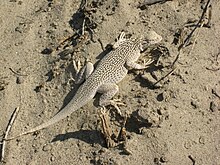 |
| Uma scoparia | Mojave fringe-toed lizard | Mojave Desert between Death Valley and Colorado River |  |
| Urosaurus graciosus | Long-tailed brush lizard | Sonoran and Mojave Deserts |  |
| Urosaurus microscutatus | Small-scaled lizard | East side of Peninsular Ranges south of Borrego Palm Canyon, Marron Valley, Cottonwood, and Deerhorn Flat areas on the west side. |  |
| Urosaurus ornatus | Ornate tree lizard | Native along Colorado River, introduced in San Bernardino County and El Centro |  |
| Uta stansburiana | Common side-blotched lizard | Southern California north to Bay Area, excluding the Central Valley and including Great Basin Desert near Nevada |  |
Family Phyllodactylidae
| Species | Common name | Occurrences | Photo |
|---|---|---|---|
| Phyllodactylus nocticolus | Peninsular leaf-toed gecko | East of Peninsular Ranges, south of Palm Springs |  |
Family Scincidae
| Species | Common name | Occurrences | Photo |
|---|---|---|---|
| Chalcides ocellatus [i] | Ocelated skink | Small populations in San Bernardino and San Diego Counties |  |
| Plestiodon gilberti | Gilbert's skink | Sierra Nevada, Coast, Transverse, and Peninsular Ranges, with populations in Mojave Desert |  |
| Plestiodon skiltonianus | Western skink | Coastal and Northern California, with populations in Sierra Nevada and Great Basin Desert |  |
| Trachylepis Quinquetaeniata [i] | African five-lined skink | Glendora, Los Angeles County |  |
Family Teiidae
| Species | Common name | Occurrences | Photo |
|---|---|---|---|
| Aspidoscelis hyperythrus | Orange-throated whiptail | Coastal Southern California west of Peninsular Ranges |  |
| Aspidoscelis tigris | Tiger whiptail | Desert regions, Central Valley, Coast, Transverse, and Peninsular Ranges |  |
| Aspidoscelis sonorae [i] | Sonoran spotted whiptail | Orange and northern San Diego Counties |  |
Family Xantusiidae
| Species | Common name | Occurrence | Photo |
|---|---|---|---|
| Xantusia gracilis [e] | Sandstone night lizard | Anza-Borrego State Park |  |
| Xantusia henshawi | Granite night lizard | Peninsular Ranges south of San Gorgonio Pass |  |
| Xantusia riversiana [e] | Island night lizard | Santa Barbara Island, Sutil Islet, San Clemente Island, and San Nicolas Island |  |
| Xantusia sierrae [e] | Sierra night lizard | Southwestern foothills of the Sierra Nevada Mountains along the western edge of the Greenhorn mountains in Kern County |  |
| Xantusia vigilis | Desert night lizard | Throughout the Mojave Desert, Transverse and Coast Ranges, and southern Sierra Nevada, Santa Catalina Island population may be introduced | 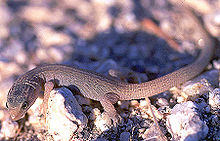 |
| Xantusia wigginsi | Baja California night lizard | Scissor's Crossing, San Diego County and east of Jacumba |  |

